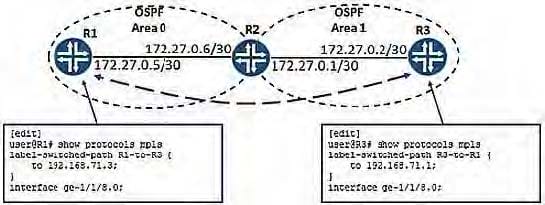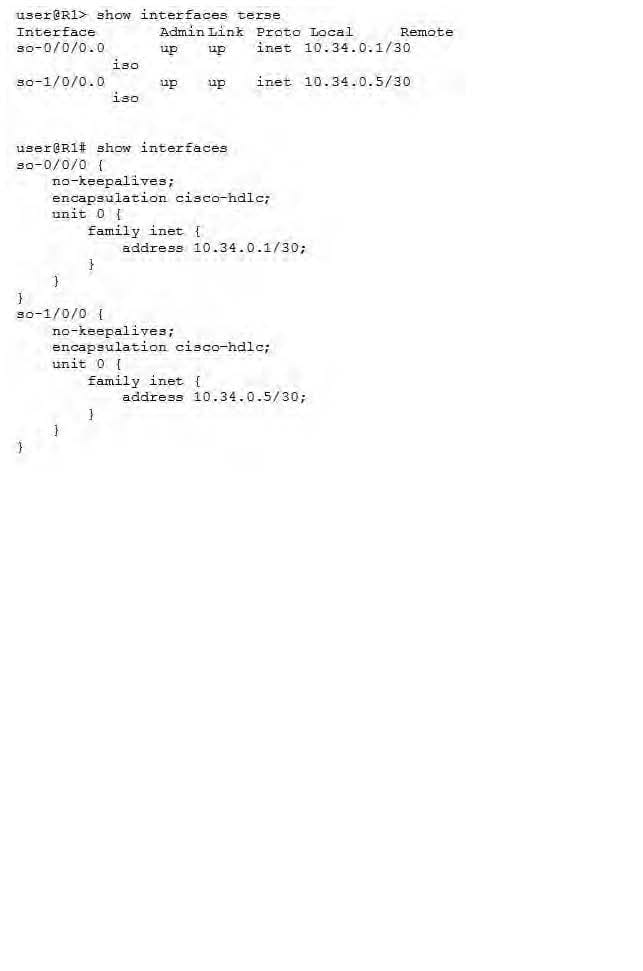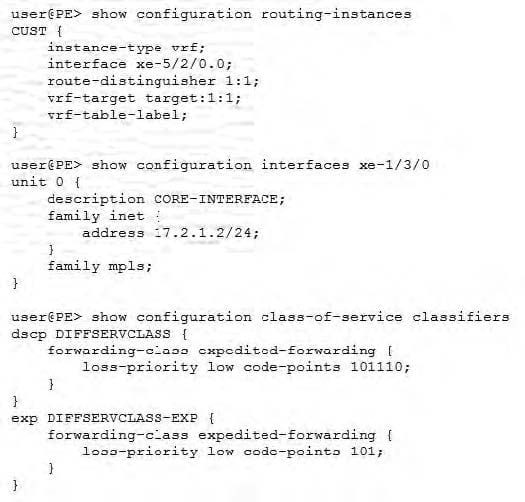Exam Details
Exam Code
:JN0-692Exam Name
:Service Provider Routing and Switching Support, ProfessionalCertification
:Juniper CertificationsVendor
:JuniperTotal Questions
:171 Q&AsLast Updated
:Jul 06, 2025
Juniper Juniper Certifications JN0-692 Questions & Answers
-
Question 161:
R1 and R2 are IS-IS Level 1 routers, but are not forming an adjacency. Which two reasons would account for this happening? (Choose two.)
A. The remote router is configured for both IPv4 and IPv6.
B. The remote router does not have family iso enabled on its interface,
C. The remote router does not have family clns enabled on its interface.
D. The remote router is not configured to participate in the same Level 1 area
-
Question 162:
An OSPF neighbor between routers R1 and R2 is stuck in loading state on R2. What are two causes? (Choose two.)
A. OSPF is not enabled on the interfaces.
B. A firewall filter is blocking OSPF hellos on both sides.
C. The R1 router has received a corrupted link-state request packet.
D. The interface MTU is mismatched between the routers.
-
Question 163:
You are asked to retain several routes from an external BGP neighbor in the routing table on your local router, but you are not allowed to forward traffic to these destinations. You have configured a forwarding table firewall filter to block these routes, and applied it under the (edit forwarding-options] hierarchy, but the routes are still showing up in the forwarding table. What is required to achieve this task?
A. Configure an EBGP import policy on your local router to block the routes.
B. Have the EBGP neighbor configure an export policy to block the routes.
C. Configure an export policy for the forwarding table to block the routes.
D. Use the no-install configuration statement within the EBGP neighbor group on your local router.
-
Question 164:
Your currently configured regular expression does not match the AS path shown below:
2135 55 55 55 55 3796
Which three regular expressions would match this path? (Choose three.)
A. "."2135"
B. "2135.*"
C. "* 55(1, 3) *"
D. "2135 55(5) 3796"
E. "2135 55(1, 2) 3796"
-
Question 165:

Referring to the exhibit, which two statements are correct about the LSP? (Choose two.)
A. The primary LSP flapped following a link flap.
B. The LSP will go down after 51 seconds.
C. The head-end is signaled that the LSP is protected following a link flap.
D. The LSP constraint checks are failing following a link flap.
-
Question 166:
You have recently added LDP-signaled VPLS to your network. The VPLS connections are established and you have been asked to verify that the forwarding plane is working properly. Which three commands would you use? (Choose three.)
A. ping mpls Idp
B. show vpls connections
C. traceroute mpls Idp
D. show vpls mac-table
E. show Idp statistics
-
Question 167:
You have configured bidirectional LSPs between R1 and R3. You notice that the LSPs are not coming up.

Referring to the exhibit, which statement is correct?
A. You must disable CSPF for the LSPs.
B. You must enable CSPF for the LSPs.
C. You must ensure type 5 LSAs are allowed in area 1.
D. You must ensure OSPF traffic engineering is configured.
-
Question 168:


You have created a new IS-IS adjacency between identical routers over two STM-4 circuits. After enabling no-keepalives on the interfaces, they come up and you are able to ping between the routers. However, the IS-IS adjacency still will not establish.
Which step will determine the cause of the problem?
A. Disable no-keepalives from the interfaces and issue a show isis adjacency command.
B. Enable family iso on all the SONET interfaces, commit, and test the circuits.
C. Disable cisco-hdlc encapsulation, enable ppp encapsulation, commit, and test the circuits.
D. Disable no-keepalives from the interfaces and issue a show interfaces extensive command for each of the SONET interfaces.
-
Question 169:
You have applied a customized EXP rewrite rule on router R1 on the egress of the interface connecting to router R2. You want to verify if it is working properly. Which two methods would you use to accomplish this task? (Choose two.)
A. Apply a rewrite rule on the ingress of R2 for packets coming in from R1 and count those packets for the new EXP values with a firewall filter as they leave R2.
B. Use the traceroute utility.
C. Use an output filter on R1 that matches and counts on various EXP values on packets going to R2.
D. Use an input firewall filter on R2 that matches and counts on various EXP values on packets coming from R1.
-
Question 170:

Referring to the exhibit, which configuration is required on the Layer 3 VPN PE router to classify EF packets from the core MPLS network into the expedited-forwarding queue?
A. Set class-of-service interfaces xe-1/3/0 unit 0 classifiers dscp default
B. Set class-of-service interfaces xe-1/3/0 unit 0 classifiers dscp DIFFSERVCLASS
C. Set class-of-service interfaces xe-1/3/0 unit 0 classifiers exp default
D. Set class-of-service routing-instances CUST classifiers exp DIFFSERVCLASS-EXP
Related Exams:
JN0-102
Internet Associate, Junos(JNCIA-Junos)JN0-104
Junos, Associate (JNCIA-Junos)JN0-105
Junos, Associate (JNCIA-Junos)JN0-1101
Juniper Networks Certified Design Associate (JNCDA)JN0-1103
Design, Associate (JNCIA-Design)JN0-130
Juniper networks Certified internet specialist.e(jncis-e)JN0-1301
Data Center Design, Specialist (JNCDS-DC)JN0-1302
Data Center Design Specialist (JNCDS-DC)JN0-1331
Security Design, Specialist (JNCDS-SEC)JN0-1332
Security Design, Specialist (JNCDS-SEC)
Tips on How to Prepare for the Exams
Nowadays, the certification exams become more and more important and required by more and more enterprises when applying for a job. But how to prepare for the exam effectively? How to prepare for the exam in a short time with less efforts? How to get a ideal result and how to find the most reliable resources? Here on Vcedump.com, you will find all the answers. Vcedump.com provide not only Juniper exam questions, answers and explanations but also complete assistance on your exam preparation and certification application. If you are confused on your JN0-692 exam preparations and Juniper certification application, do not hesitate to visit our Vcedump.com to find your solutions here.